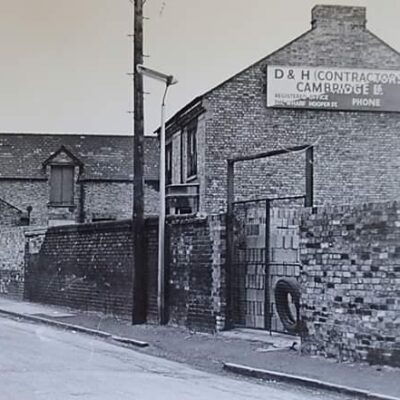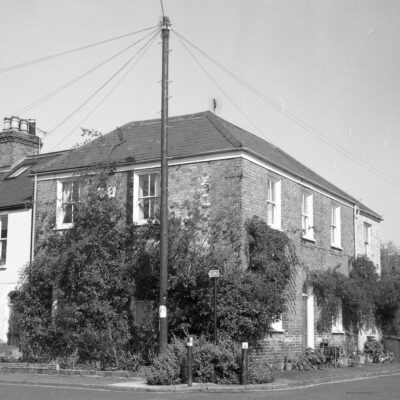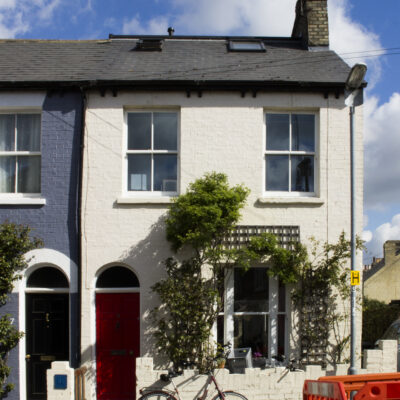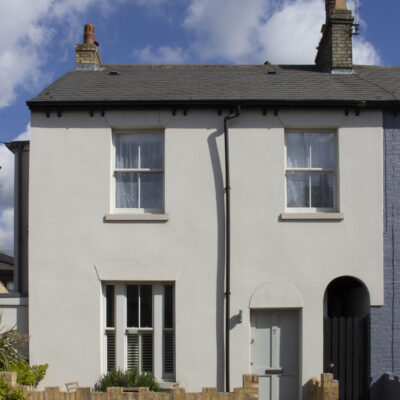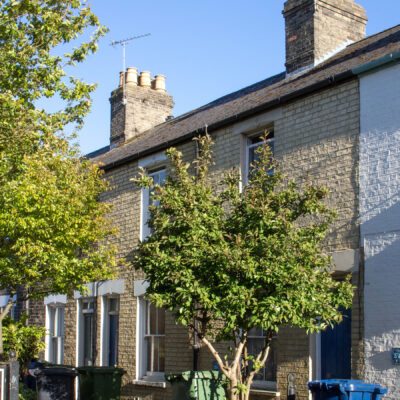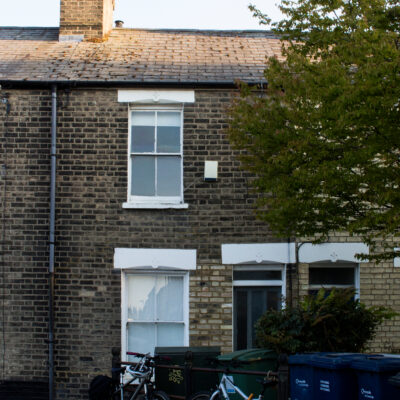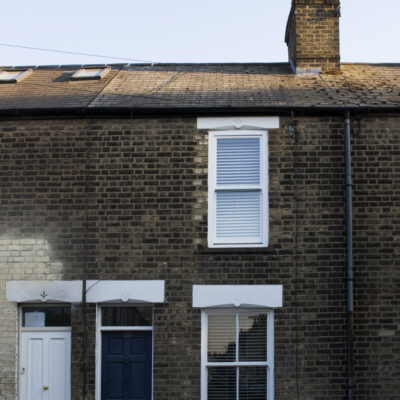Search by topic
- archaeology
- Building of Local Interest
- charity
- church
- crime
- dressmaker
- fire
- Great Eastern Railway
- Listed building
- Mapping Relief
- medieval
- oral history
- poverty
- Public House
- Rattee & Kett
- Religious House
- Roman
- scholar
- school
- Then and Now
- tudor
- women
- work
- world war one
- world war two
Search by text
5 Hooper Street, Wembley
Wembley, 5 Hooper Street
Wembley, 5 Hooper Street, is a large detached house built around 1881, and now divided into flats. The original house was smaller, but has been extended on the western side in recent decades. Its immediate neighbours are no. 3 (Jubilee House) and no. 6. Behind the house there was once a workshop, now replaced by modern houses.
It first appears as no. 5 in the 1901 census, but it may be the house listed as no. 3 in the 1891 census: see notes below.
1891 census (3 Hooper Street)
George H Himus, 35, dairyman & carpenter, b. Cambridge
Sarah E Himus, 27, b. Cambridge
Henry W Himus, 3, b. Cambridge
Jessie M Himus, 2 months, b. Cambridge
William J Banyard, lodger, 30, draper’s assistant, b. Cambridge
William Banyard was Sarah Himus’s brother.
In the Kelly’s Directory of 1883, under the heading ‘Dairymen and cowkeepers’, George’s father Henry Hymus was listed as living at 3 Hooper Street. Just two years earlier, in the 1881 census, he lived at 6 Hooper Street. The 1881 census indicates that the plot between no. 6 and no. 2 (the number then used for Jubilee House) was a building site: it is marked ‘1B’, where B = ‘building’. It’s possible that the newly finished house was initially called no. 3 but later became no. 5.
1901 census (5 Hooper Street)
Charles Sharpe, 40, furniture dealer, b. Cambridge
Mary Sharpe, 42, b. Cambridge
Frederick Sharpe, 21, porter (light), b. Cambridge
Nellie Sharpe, 18, b. Cambridge
Earnest Sharpe, 17, b. Ely
May Sharpe, 16, b. Ely
Ethel Sharpe, 16, b. Ely
Ada Sharpe, 16, b. Ely
Bertie Sharpe, 15, b. Ely
Florie Sharpe, 12, b. Ely
Edith Sharpe, 6, b. Cambridge
May and Ethel Sharpe were twins; their sister Ada was actually 14 or 15. The Sharpes were to have twelve children in total.
In 1891 the family had been living in Ely. All the children attended school except for 11 year-old Jessie: by her name in the census record are the words ‘school mistress refused to have her’.
Charles Sharpe was a furniture dealer running his business from home, and he would have used the workshops behind the house. He occasionally advertised more unusual items for sale in the newspapers, including this one from the Cambridge Daily News of 10 January 1902:
The same month he was fined 2 shillings and 6 pence (Cambridge Daily News, 11 January 1902) for leaving his horse and van on the highway in Harston for a ‘long and unreasonable time’ – 52 minutes: ‘Defendant expressed his regret … He was at a wood sale, and thought he was not away for more than a quarter of the time he was.’
In 1905, Cambridge Borough Council approved plans submitted by the owner, Mrs Waters, to build a shop on the western side of the house. The plans, held at the Cambridgeshire Archives in Ely (KCB/2/SE/3/9/2349), show a single-storey shop front with a large double window, and a roof sloping to the rear. A photograph from 1978, also held at the Archives (KCB/2/SE/4/3/1501), shows that the shop had been demolished by that year, but the sloping line of the roof was still visible in the brickwork.
By 1911 Charles Sharpe had moved his family to Newmarket Road, but Kelly’s Directory of 1916 still lists the business at 5 Hooper Street, suggesting that he kept the use of the shop. In 1916 he was fined for violating wartime lighting regulations by leaving a window of his Hooper Street workshop uncovered at night (Cambridge Independent Press, 17 March 1916).
1911 census (5 Hooper Street)
John Parkes, 28, fish merchant, employer, b. Sleaford, Lincolnshire
Mabel Parkes, 21, b. Boston, Lincolnshire
Leonard Parkes, 3, b. Cambridge
Thomas Hague, boarder, 23, fish hawker, b. Sheffield
John Parkes was from Sleaford but brought up in Boston, Lincolnshire, where he met Mabel. His father was a trawlerman, and had been away at sea during the 1901 census.
(Email 2022 from BP) : John and Mabel Parkes were my great grandparents and their son Leonard, my grandfather. John was the brother of Sir Fred Parkes of the Boston Deep Sea Fishing and Ice Company. By 1921 the family were living in Brompton near Northallerton. Unfortunately John suffered from tuberculosis and died in 1928 in the workhouse in Northampton. Mabel later returned to the Boston area and remarried in 1945 to Arthur Smith who I believe was a witness at Mabel and John’s wedding in Cambridge in 1907. My grandfather Leonard disappeared three weeks before the outbreak of WWII and was said by my grandmother’s family to have been killed on a trawler which was requisitioned as a minesweeper by the navy during the war, although I have found no evidence of this. I would love to find out what happened to him. My father was nearly 5yrs old when Leonard went missing.
1921 census
John Percival Harper, head, 44, plumber, gas & hot water fitter, employer, b. Ealing, London
Nelly Harper, wife, 40, b. Newmarket, Cambridgeshire
John Robert Harper, son, 10, b. Cambridge
From 1927, trade directories list Arthur Allebone, plumber, as resident at no. 5, with John Harper still using the workshop.
1939 England and Wales register (5 Hooper Street)
The inhabitants were Arthur Allebone, his wife Kate, and five sons and daughters. Arthur was a master plumber, and two of his adult sons worked in the family business.
Arthur, Kate and two of their sons were still living at the house in the 1950s, and Arthur was living there into the 1970s.
In 2023 AC sent an email to Capturing Cambridge:
My grandfather was Arthur Allebone of 5 Hooper Street. He went blind in his older years. My dad was Sidney Allebone. He was a plumber in his dad’s business along with Arthur Jnr. I used to take the wages over to my uncle. I went to work with dad on the the bar of his bike some days. Granddad used the White Heart pub on the corner; my boyfriend and I used to to call in and have a drink with him.
Sources
UK census records (1841 to 1921), General Register Office birth, marriage and death indexes (1837 onwards), the 1939 England and Wales Register, electoral registers, trade directories, and local newspapers available via www.britishnewspaperarchive.co.uk. The plans for the shop are
Contribute
Do you have any information about the people or places in this article? If so, then please let us know using the Contact page or by emailing capturingcambridge@
License
This work is licensed under CC BY-NC-SA 4.0






